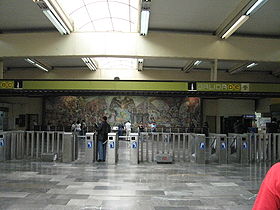
Metro Universidad
Encyclopedia
| Universidad Mexico City Metro Mexico City Metro The Mexico City Metro , officially called Sistema de Transporte Colectivo, is a metro system that serves the metropolitan area of Mexico City... |
Metro Copilco
Metro Copilco is a station along Line 3 on the Mexico City Metro. Located in the Coyoacán borough, in the south of Mexico City, on Avenida Enríquez Ureña...
Line 3
Mexico City Metro Line 3
Mexico City Metro Line 3 is one of the 16 metro lines built in Mexico City, Mexico.Line 3 is the longest line, its color is olive green and it runs from north to south of the city covering almost all of it....
None

station
Metro station
A metro station or subway station is a railway station for a rapid transit system, often known by names such as "metro", "underground" and "subway". It is often underground or elevated. At crossings of metro lines, they are multi-level....
on the Mexico City Metro
Mexico City Metro
The Mexico City Metro , officially called Sistema de Transporte Colectivo, is a metro system that serves the metropolitan area of Mexico City...
. It is located in the southern reaches of Mexico City
Mexico City
Mexico City is the Federal District , capital of Mexico and seat of the federal powers of the Mexican Union. It is a federal entity within Mexico which is not part of any one of the 31 Mexican states but belongs to the federation as a whole...
, in Coyoacán
Coyoacán
Coyoacán refers to one of the sixteen boroughs of the Federal District of Mexico City as well as the former village which is now the borough’s “historic center.” The name comes from Nahuatl and most likely means “place of coyotes,” when the Aztecs named a pre-Hispanic village on the southern shore...
borough. A surface station, it is the current terminus of Line 3
Mexico City Metro Line 3
Mexico City Metro Line 3 is one of the 16 metro lines built in Mexico City, Mexico.Line 3 is the longest line, its color is olive green and it runs from north to south of the city covering almost all of it....
. The station was opened on 30 August 1983.
The station logo is a crest bearing a bird with the head of a condor and of an eagle, and the legend "Por mi Raza hablará el Espíritu"; this is the official coat of arms of the Universidad Nacional Autónoma de México (UNAM), which the station serves.
This metro terminal is multimodal, connecting with microbus lines that serve zones like Tlalpan
Tlalpan
Tlalpan is one of the sixteen administrative boroughs of the Federal District of Mexico City. It is the largest borough, with over eighty percent under conservation as forest and other ecologically sensitive area. The rest, almost all of it on the northern edge, has been urban since the mid 20th...
, Ajusco
Ajusco
Ajusco is a lava dome volcano located just south of Mexico City, Mexico, in the Tlalpan borough of the city. It is the highest point in the Mexican Federal District, which contains Mexico City.-Etymology:...
, Milpa Alta
Milpa Alta
Milpa Alta is one of the 16 delegaciones into which Mexico's Federal District is divided. It lies in the southeast corner of the Distrito Federal, bordering the States of México and Morelos. It is the second largest and most rural of all delegaciones. It is also the least populous and...
and Contreras
Magdalena Contreras
La Magdalena Contreras is one of the 16 delegaciones into which Mexico's Federal District is divided. It had a 2010 census population of 239,086 inhabitants, and is the third-least populous of Mexico City's boroughs. It lies at an elevation of 2,365 m...
. It also connects with the UNAM's internal bus base, with buses that give free service on the campus, between schools, institutes and sports facilities, including the México 68 Olympic Stadium
Estadio Olímpico Universitario
Estadio Olímpico Universitario is a stadium located in Ciudad Universitaria, Mexico City. It was built in 1952 and at that time was the largest stadium in Mexico. This stadium has a capacity of 63,186 . During the 50s and the 60s this stadium was used mostly for college American football matches...
. It also serves the Pedregal de Santo Domingo and Copilco el Alto neighbourhoods.
Metro Universidad also has facilities for the handicapped, and a large mural depicting the history of UNAM.

